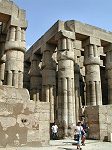 papyrus column
papyrus column
|
 The
temple of Luxor was erected in the very heart of the ancient city of Thebes.
It is consecrated to God Amun and connected to the Temple of Kamak by a
1.84 ml (3 km) long processional way, which Amenophis III lined with ram
headed Sphinxes, like those still to be seen in Kamak. The human heads
are from a later date. The
temple of Luxor was erected in the very heart of the ancient city of Thebes.
It is consecrated to God Amun and connected to the Temple of Kamak by a
1.84 ml (3 km) long processional way, which Amenophis III lined with ram
headed Sphinxes, like those still to be seen in Kamak. The human heads
are from a later date. |
  The
temple of Luxor is much smaller than that of Kamak; however it is also
magnificent and of majestic beauty. As in Kamak, a monumental entrance
gate leads into a large courtyard beyond which is a hypostyle hall with
gigantic columns, followed by the actual sanctuary, to which only pharaohs
and priests were allowed access. Colossal statues, as well as fascinating
reliefs with hieroglyphic inscriptions and graphic representations, tell
of the heroic deeds of the Pharaohs and the history of Egypt. The
sight of such gigantic masterly achievements of old Egyptian architecture
inspired us again and again with deep respect, admiration and enthusiasm. The
temple of Luxor is much smaller than that of Kamak; however it is also
magnificent and of majestic beauty. As in Kamak, a monumental entrance
gate leads into a large courtyard beyond which is a hypostyle hall with
gigantic columns, followed by the actual sanctuary, to which only pharaohs
and priests were allowed access. Colossal statues, as well as fascinating
reliefs with hieroglyphic inscriptions and graphic representations, tell
of the heroic deeds of the Pharaohs and the history of Egypt. The
sight of such gigantic masterly achievements of old Egyptian architecture
inspired us again and again with deep respect, admiration and enthusiasm.
 The
temple building dates back to the XVIII. Dynasty (1567-1320 BC) or
earlier and was continued over centuries. In the course of the time,
it reached a dimension of almost 284 yd (260 m)! In the present
temple building Amenophis III (1402-1364 BC) and Ramses II (1279-1213
BC) were essentially involved, but also also Hatshepsut, Tuthmose III and
other pharaohs left behind their traces. The
temple building dates back to the XVIII. Dynasty (1567-1320 BC) or
earlier and was continued over centuries. In the course of the time,
it reached a dimension of almost 284 yd (260 m)! In the present
temple building Amenophis III (1402-1364 BC) and Ramses II (1279-1213
BC) were essentially involved, but also also Hatshepsut, Tuthmose III and
other pharaohs left behind their traces.
It is an interesting fact that one of the two original
obelisks (82 ft (25 m) in front of the Pylon was removed by the French
– 1835/36. and reconstructed on the Place de la Concorde in Paris.
In exchange, Egypt received a clock for the Alabaster Mosque in Cairo. |